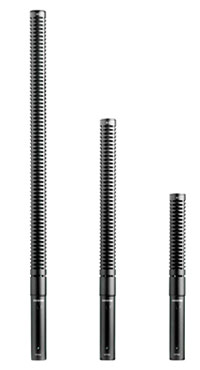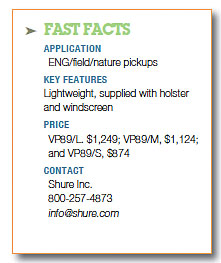The VP89 is a new family of shotgun microphones from Shure introduced at the 2011 NAB Show. The mics—VP89/L, VP89/M and VP89/S—are long, medium and short (respectively) electret condenser shotgun mics that are well suited for fairly long range pickup in outdoor situations such as may be encountered in ENG and sports applications.

Shure VP89 microphone seriesFEATURES
The shotgun bodies are charcoal-grey metallic painted aluminum alloy with a stainless steel screen. They require 11-52 VDC of phantom power for operation. Each interference tube capsule comes with, and uses its own, Shure VP89 XLR-terminated power supply with high-pass filter. There is no pad.
The mics are supplied in a handy and sturdy vinyl-clad hard tube holster large enough to accept the mic with its included foam wind filter. If more wind protection is required, Shure has three sizes of pistol-grip based windshields, one for each length, and a Rycote Lyre suspension mount that works very well. As the system is modular, you can use the medium length windshield on the VP89/M, and by removing one section, it also works on the VP89/S. The fur will be too long, but most of the wind protection comes from the cage and not the fur. The A89MW-kit runs $874. Shure also has Rycote Lyre suspension mounts as options with camera mount, pistol grip and boom adapters.
The VP89/L, VP89/M and VP89/S are lightweight (tipping the scales at 6.0, 4.9 and 4.1 ounces in that order); coming in on either side of the comparable 5.8 ounce Sennheiser MKH 416 and and 5.9 ounce Rode NTG-3.
The self-noise figures for the Shure microphones are 2 dB quieter than for my MKH 416 and NTG-3, but the latter are much more sensitive, so when you adjust gain for equal loudness, the self-noise is slightly audible in the Shures in a quiet room, but inaudible in the Rode and Sennheiser. On a noisy street, you won't hear it.
You will hear it if you're cranking up the gain in search of distant wildlife, helicopters and fixed winged aircraft or pets on leashes, which is exactly what my suburban neighborhood gave me while testing these three mics. These mics prefer to be in the thick of it, not in the thicket or chasing down lions on the plains of the Serengeti.
IN USE
The Shure shotgun set came with those little rubber snuggies inserted in the male XLR connectors, which, in my case, kept them from being fully connected to a locking XLR terminated cable. I fished them out with a small screw driver and got the connector to seat properly and latch.
I used my Sound Devices 442 mixer to compare the Shures with other shotgun mics in my collection—a Sennheiser MKH 416 and a Rode NTG-3. I soon found that without any wind protection, the new Shure shotguns have a little more "bite" than the MKH 416 and NTG-3; however, the included Shure foam wind filter takes a bit of that edge off.
Even without the high-pass filter engaged, the frequency response of the Shure shotguns starts fading below 400 Hz for the VP89L, and below 300 Hz for the VP89M and VP89S. I think this is a purposeful design choice. Shotgun mics use a slotted interference tube to increase their directivity. While that makes them very directional at high frequencies, they remain much less directional at middle and low frequencies. And shotgun mics pick up a lot of off-axis mid and low frequencies, especially in reflective environments, That's part of the reason that wall and ceiling bounce found in most interior settings makes a hypercardioid a better choice. Even exteriors with highly reflective surfaces, e.g. hard flat walls and pavement, can make a good hypercardioid a better choice than a shotgun.
One way to solve the problem of off-axis low- and mid-frequency sound getting into your shotgun is to design a mic with lower sensitivity at those frequencies. That's exactly what Shure has done with the VP89/L, M and S. By eliminating problem frequencies before they get to the mixer, you don't needlessly tax the circuitry with harmonic and headroom bloat. This choice helps in rumbling run and gun situations, media frenzies and big venue sporting events, or if you spend a lot of time on the street battling car and truck noise. The compromise is that human chest tones are in that same range and cutting them thins the voice—perhaps not the thing you want for narrative film dialog or documentaries, but very effective for ENG.

From long to short, the main patterns of the mics are listed respectively as 30, 50 and 70 degrees wide. That sounds about right, based on what I experienced in my tests. I also noticed that unlike some shotguns, there aren't any nasty beams at the edges of the pattern or elsewhere as you go off-axis. The VP89/L has the smoothest edge. The VP89/S has a noticeable pattern edge and the VP89/M is somewhere in between.
These days, with 16:9 and wide angle lenses, it's easy to catch a camera-mounted shotgun when you pull back for the ultra wide shot. The A89U is a neat accessory for camera-mounting that shortens the length of each mic by up to six inches. It's a simple but elegant U-turn. To use it, simply unscrew the mics from their inline power supplies and insert the A89U. Check your camera's mic suspension to make sure it will accommodate the new configuration, but this one accessory may come in very handy.
SUMMARY
The Shure VP89/L/M/S and accessories are a solid family of tools targeting the ENG market. They are well made, light weight and simply functional.
Ty Ford has been reviewing pro audio gear for more than 20 years. He may be contacted at www.tyford.com.
The professional video industry's #1 source for news, trends and product and tech information. Sign up below.
